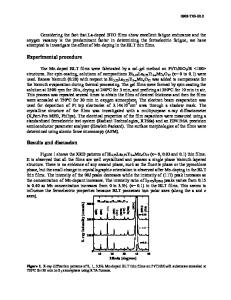Studies of structural and electrical properties of (Pb 0.9 Bi 0.05 Dy 0.05 )(Fe 0.1 Ti 0.9 )O 3 ceramic
- PDF / 2,545,797 Bytes
- 11 Pages / 595.276 x 790.866 pts Page_size
- 110 Downloads / 245 Views
Studies of structural and electrical properties of (Pb0.9Bi0.05Dy0.05) (Fe0.1Ti0.9)O3 ceramic Rutuparna Das1 · Prince Kumar2 · R. N. P. Choudhary1 Received: 14 July 2020 / Accepted: 12 October 2020 © Springer-Verlag GmbH Germany, part of Springer Nature 2020
Abstract In this communication, detailed studies of structural, dielectric, and electrical characteristics of dysprosium (Dy)-modified bismuth ferrite–lead titanate ( BiFeO3–PbTiO3) solid solution, [i.e., ( Pb0.9Bi0.05Dy0.05)(Fe0.1Ti0.9)O3)], prepared by a standard high-temperature solid-state reaction route, have been reported. From the preliminary X-ray structural analysis with Rietveld refinement method, the structure of the material is found to be tetragonal. Detailed analysis of surface morphology, X-ray energy-dispersive spectra and elemental mapping has shown uniform distributions of grains of varying size and elemental composition of the compound. The frequency dependence of the dielectric constant has been explained by the Maxwell–Wag bTiO3) have high-temperature ferroelectric transition, ner model. As both the components of the solid solution ( BiFeO3 and P no dielectric anomaly has been observed in the said experimental range of our temperature dependence of dielectric studies. The detailed analysis of Nyquist plots, using impedance data collected in a wide range of frequency and temperature shows the contributions of both grains and grain boundaries in the resistive and capacitive characteristics of the prepared material. Both negative and positive temperature coefficients of resistance behaviour are observed in the material. The frequency and temperature dependence of ac conductivity obeys Jonscher’s power law and Arrhenius equation. The occurrence of electric field dependence (P–E) hysteresis loop at room temperature shows the ferroelectric property of the material. Keywords Solid-state reaction · XRD · Dielectric · Impedance analysis · Ferroelectric property
1 Introduction Some perovskites of a general chemical formula, A BO3 (A = mono/divalent and B = tri-pentavalent ions) have shown very important structural and physical characteristics [1]. Therefore, detailed studies of various physical properties including dielectric and ferroelectric of simple or/and modified perovskites have become significant for both fundamental investigations as well as device purpose [2, 3]. Some materials of the perovskite family, such as P bTiO3, Pb(ZrTi) O3 (PZT), Pb(FeNb)O3, BaTiO3 (BT), and (BaSr)TiO3, are more interesting and important because of their high dielectric constant, high piezoelectric constant, low tangent loss, and room temperature ferroelectric phase transformation * Rutuparna Das [email protected] 1
Department of Physics, Siksha O Anusandhan (Deemed to be University) Bhubaneswar, Bhubaneswar 751030, India
Gandhi Institute For Technological Advancement (GITA) Bhubaneswar, Bhubaneswar 751030, India
2
[4]. Barium titanate ( BaTiO3)-based positive temperature coefficient of resistivity (PTCR) ceramics is very significant
Data Loading...











